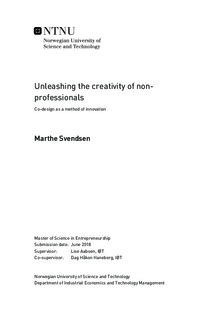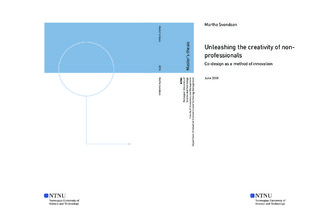| dc.description.abstract | This thesis explores co-design as a methodology for innovation processes involving non-professionals. Co-design as a method of innovation is increasing in popularity and becoming more widespread (Sanders and Stappers, 2016, Steen et al., 2011).
In order to include everyday people in innovation processes by the use of co-design, knowledge on the experience of participation is necessary. However, there is a gap in the theoretical field of co-design concerning the experience of participants.
The purpose of the thesis is therefore to explore co-design processes. To fulfill this purpose, three research questions has been developed: 1. How is a co-design process performed? 2. How is a co-design process experienced? 3. Which factors affect a co-design process?
The empirical material consists of ten interviews and nine hours of observation. In response to the purpose of the thesis, the author has compared two different innovation processes, which have been analyzed by a co-design framework. Process one was conducted by a multidisciplinary team at a Norwegian university, and process two were conducted by a multidisciplinary team at a college in the Netherlands. The methodological approach has been qualitative and exploratory, and two separate within-case analyses has been conducted, as well as a cross-case analysis.
The analysis reveals important similarities between the two processes. In both processes the teams are struggling with performing abduction, as well as identifying a real problem or user need in the research phase of the process. The teams also need much closer facilitation in the phases of analysis, concepting and prototyping. Another important finding is that participants want restrictions on the process, but not on the final solution. The thesis reveals that factors that influence the co-design process has shown to be mainly three; the facilitators, the design of the presented challenges and the client, which again influence the motivation of the participants.
The thesis lastly presents an updated process model of co-design based on the findings from the empirical data review. | |

